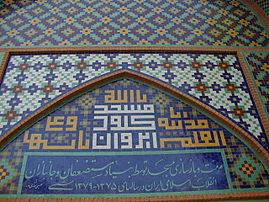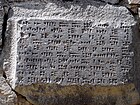Blue Mosque, Yerevan: Difference between revisions
No edit summary |
Ninetoyadome (talk | contribs) Reverted to revision 791740244 by InternetArchiveBot (talk). (TW) |
||
| Line 36: | Line 36: | ||
}} |
}} |
||
The '''Blue Mosque''' ({{lang-hy|Կապույտ մզկիթ}}, ''Kapuyt mzkit''; |
The '''Blue Mosque''' ({{lang-hy|Կապույտ մզկիթ}}, ''Kapuyt mzkit''; {{lang-fa|مسجد کبود}} ''Masjed-e Kabud'') is an 18th-century [[Shia Islam|Shia]] mosque in [[Yerevan]], [[Armenia]]. During the Soviet era, the mosque stopped its services and housed the History Museum of Yerevan. Following [[Armenian independence referendum, 1991|Armenia's independence]], the mosque was renovated with the support from the Iranian government and again started acting as a mosque, mostly for Iranians residing in the country. It is currently the only active mosque in Armenia.<ref>{{cite news|title=Armenia applies to place Blue Mosque on UNESCO’s World Heritage List|url=http://www.todayszaman.com/world_armenia-applies-to-place-blue-mosque-on-unescos-world-heritage-list_304799.html|work=[[Today's Zaman]]|date=22 January 2013|deadurl=yes|archiveurl=https://web.archive.org/web/20151221033541/http://www.todayszaman.com/world_armenia-applies-to-place-blue-mosque-on-unescos-world-heritage-list_304799.html|archivedate=21 December 2015|df=}}</ref> |
||
== History == |
== History == |
||
Revision as of 16:41, 4 October 2017
| Blue Mosque | |
|---|---|
 | |
| Religion | |
| Affiliation | Islam |
| Rite | Twelver Shia |
| Ecclesiastical or organizational status | Mosque |
| Location | |
| Location | 12 Mashtots Avenue, Yerevan, Armenia |
| Geographic coordinates | 40°10′41″N 44°30′20″E / 40.1781°N 44.5056°E |
| Architecture | |
| Style | Islamic |
| Completed | 1764-68 |
| Specifications | |
| Dome(s) | 1 |
| Minaret(s) | 1 |
| Minaret height | 24 m |
The Blue Mosque (Armenian: Կապույտ մզկիթ, Kapuyt mzkit; Persian: مسجد کبود Masjed-e Kabud) is an 18th-century Shia mosque in Yerevan, Armenia. During the Soviet era, the mosque stopped its services and housed the History Museum of Yerevan. Following Armenia's independence, the mosque was renovated with the support from the Iranian government and again started acting as a mosque, mostly for Iranians residing in the country. It is currently the only active mosque in Armenia.[1]
History
Background
The Yerevan region had been under the control of various Muslim rulers since the incursions of Timur in the 14th century. From the early 16th century, and decisively with the 1555 Peace of Amasya, until the course of the 19th century, it had intermittently been a province of Iran (ruled successively by the Safavids, Nadir Shah, Karim Khan Zand and the Iranian Qajar Dynasty), before it fell to neighboring Imperial Russia through the Russo-Persian War of 1826-1828 and the resulting Treaty of Turkmenchay of 1828.[2]
For the mosque's construction, various dates from the mid-18th century are cited in literature. As reported by 19th-century traveller H.F.B. Lynch, the Blue Mosque was commissioned to be built during the reign of Iranian ruler Nadir Shah (1736–47) by Husayn Ali Khan.[3] George Bournoutian names Husayn Ali Khan as the patron of the building, but places his reign in the years 1762-83.[4] According to Vladimir M. Arutyunyan et al. construction started in 1760 and was completed under Husayn Ali Khan in 1764-68.[5][6]
The building was the main congregational mosque for the city. When Yerevan was captured by Russia in 1827 during the 1826-1828 Russo-Persian War it was, according to the cataster drawn up by the Russians, the largest of its eight functioning mosques. The building consisted of the main prayer hall, a library, and a madrasa with 28 cells, all organised around a courtyard, with the overall complex occupying 7,000 square metres of land. There is a single minaret at the main portal, in keeping with contemporaneous mosques, and there is no evidence that there were more minarets.
Soviet era
Due to the secularist policies of the Soviet government, religious services at the Blue Mosque were stopped and in 1931 it was used to house the Museum of the City of Yerevan.[7]
Independent Armenia
In the latter half of the 1990s the mosque underwent a total restoration, funded by Iran, that was completed in 1999. United States Department of State employee and foreign service officer Brady Kiesling referred to the restoration as "structurally necessary but aesthetically ambiguous."[8] The restoration raised concerns among some officials in the Republic of Azerbaijan as the mosque was presented as an Iranian mosque, which in Azerbaijan is claimed as belonging to the heritage of the once large Azerbaijani community of Armenia.[9] Islamic religious services have now resumed within the Blue Mosque, which is the only operating mosque in Armenia. The Museum of the City of Yerevan is now housed in a purpose-built building on another site.
The mosque's ownership was given to Iran in 1995 by the Yerevan city authorities.[10] In December 2015 the Armenian government made a decision to extend Iranian ownership of the mosque for 99 years.[11]
Gallery
-
The Blue Mosque in Yerevan, view from the courtyard towards the prayer hall (photo F. Sarre, 1897)
-
by Panos Terlemezian, 1917
-
The entrance and the dome
-
Entrance
-
Entrance details
-
Secondary entrance of the Blue Mosque in Yerevan, added in the late 19th century to the original plan
-
A modern view from the courtyard towards the prayer hall
-
Minaret of the Blue Mosque
-
Closer view of the minaret
-
Closer view of the dome
-
Interior view of the dome
-
Interior
See also
- Erivan Khanate
- Islam in Armenia
- Persian Armenia
- Abbas Mirza Mosque, Yerevan
- Shah Abbas Mosque, Yerevan
References
- Citations
- ^ "Armenia applies to place Blue Mosque on UNESCO's World Heritage List". Today's Zaman. 22 January 2013. Archived from the original on 21 December 2015.
{{cite news}}: Unknown parameter|deadurl=ignored (|url-status=suggested) (help) - ^ Timothy C. Dowling Russia at War: From the Mongol Conquest to Afghanistan, Chechnya, and Beyond pp 729-730 ABC-CLIO, 2 dec. 2014. ISBN 978-1598849486
- ^ Lynch 1901, p. 213–214.
- ^ Bournoutian 1992, p. 45.
- ^ Arutyunyan 1968, p. 31.
- ^ Ritter 2006, p. 363–366.
- ^ Hovhannessian 1986, p. 19-21.
- ^ Kiesling 2005, p. 31.
- ^ Zeynalov, Natiq (5 May 2010). "Yerevanda Göy məscid hər gün İran vətəndaşları ilə dolu olur". azadliq.org (in Azerbaijani). Radio Free Europe/Radio Liberty.
- ^ "Կապույտ մզկիթը 99 տարով հանձնվեց Իրանի տնօրինությանը". azatutyun.am (in Armenian). Radio Free Europe/Radio Liberty. 10 December 2015.
- ^ "Իրանի դեսպանատունը 99 տարով անհատույց կօգտագործի Կապույտ մզկիթն ու հարակից հողամասը". Hetq Online (in Armenian). 10 December 2015.
- Bibliography
- Arutyunyan, Vladimir M. (1986). Ереван (in Russian). Moscow: Izdvo litry po stroitelstvu.
{{cite book}}: Invalid|ref=harv(help)> - Ritter, Markus (2006). "Moscheen und Madrasabauten". Iran 1785–1848: Architektur zwischen Rückgriff und Neuerung (in German). Leiden: Brill. ISBN 9004144811.
{{cite book}}: Invalid|ref=harv(help) - Bournoutian, George (1992). The Khanate of Erevan Under Qajar Rule, 1795-1828. Costa Mesa, CA: Mazda Publishers. ISBN 9780939214181.
{{cite book}}: Invalid|ref=harv(help) - Hovhannessian, Hrant A (1986). The Museums of Yerevan. Yerevan: Hayastan Publishing.
{{cite book}}: Invalid|ref=harv(help) - Kiesling, Brady (2005). Rediscovering Armenia (2 ed.). Yerevan: Matit.
{{cite book}}: Invalid|ref=harv(help) - Lynch, H.F.B. (1901). Armenia, Travels and Studies. Vol. 1. London: Longmans.
{{cite book}}: Invalid|ref=harv(help)














